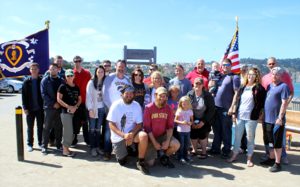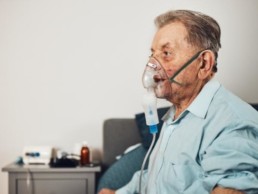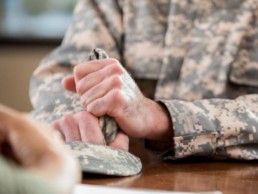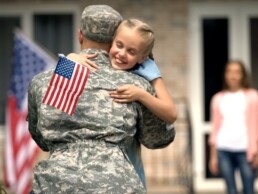Donation: Charitable PayRaise

With great excitement, we would like to officially announce the strategic partnership between The Purple Heart Foundation and The Charitable Payraise®, in time for Purple Heart Day. For over 65 years, The Purple Heart Foundation has helped fund programs and services to help veterans transition to civilian life.
The Charitable Payraise® helps facilitate a planned gift and a legacy-defining bequest. The strategic partnership with The Charitable Payraise® will allow veterans, donors, and the broader community to review their retirement and giving plans to maximize their after-tax cash flow and increase their impact.
Download the brochure to learn more.
“As the son of a son of Marine Officers, it is our honor to partner with The Purple Heart Foundation to serve those who have so honorably served us. Our mission is to expand the opportunities to give to this noble cause while helping donors improve their own retirements. We hope you will inquire about this ‘Win-Win’ opportunity,” said Bill Lloyd when describing why the partnership means so much to him personally.
One of the giving options with The Purple Heart Foundation is through bequests. If you have a highly appreciated asset, such as land, stock, etc., The Charitable Payraise® can assess if your retirement cash flow and giving can be increased. They work with your financial advisor as part of the assessment. The Charitable Payraise team has created a new financial method, and with their patented approach and financial app, it is easy to see if adding them to your financial planning makes sense.
You can learn more on Charitable Payraise’s How It Works Page about their approach and how we can help.
You can also learn more at www.charitablepayraise.com. Interested in enhancing the lives of veterans everywhere? Learn more about the amazing impacts you can make at www.purplehear2dev.wpengine.com.
Our Mission
The mission of the Purple Heart Service Foundation is to enhance the quality of life of Purple Heart recipients and other honorably discharged veterans and their families.
A Look Back At Their Walk Across America

Back in 2018, two friends, Matt Andersen & Trevor Stephens, began their journey, a “Walk Across America,” that would take a little over 6 months to raise awareness and money for a charity of their choosing. They chose that they would be walking for the Purple Heart Foundation in May 2018. They showed the power of what two people can do for the veteran community. Matt and Trevor were able to raise over $8,000 for the Purple Heart Foundation during their walk. We caught up with them to talk more in-depth about their “Walk Across America” and what they have been up to.
Thank you gentleman for taking some time to sit down and talk with us to catch up.
(Matt & Trevor): Thanks for having us. We are happy to be here talking with our friends from the Purple Heart Foundation.
Trevor, you are a veteran. How do you look back on your days on active duty?
(Trevor): Kinda like the walk, at the time it was a tough and frustrating time, and there was a lot of bad but looking back it was some of the best times of my life. It impacted me in a way that got me out of trouble. I truly believed it helped me in life in different ways.
I have a friend actually who was helped by the Purple Heart Foundation with a grant around the time we began the walk. He is doing much better and is walking with a cane. He regained most of walking with a cane. He can’t work but still does therapy and lives in North Carolina. He has a good mental mindset, he still makes jokes and has a good attitude.
Does your status as a veteran prompt you to talk about issues like veteran suicides?
(Trevor): It is important because I know a few people in connections that know others that have committed suicide. When you are in the military you know how big of a deal it is. Going through tough situations sometimes you break. There is a lot of stress so it's important to let everyone know about what is going on with our veterans.
You two are good friends from Council Bluffs, IA, but how did the walk Across America get started?
(Matt): In 2007 we met each other in middle school in Iowa. In High school we became closer friends through mutual friendships. It was Trevor's idea to do it. The road trip was scheduled after I graduated from college and Trevor came out of military duty. Trevor was watching videos of people walking long distances for music festivals in a show.
(Trevor): Going through a rabbit hole and seeing what others did to raise money for charity, I got the idea of walking across the country. I texted another friend if he wanted to walk across the country. I was not doing it by myself and texted Matt. At first he thought I was crazy. It took some convincing for Matt to finally get him to join the walk. We had brought up the idea of traveling before. Took him an hour to be set to want to do it, then 4th of July 2017 it was decided that we were going to do it.
"This is where it felt like it became bigger than us.”
It has been a little while since you did the Walk Across America, how did you both feel about doing it in the beginning? How do you feel about it now?
(Trevor): It was hard to believe that we actually did it in the end. I go back and rewatch the videos they made along the way. It was 7 months worth of videos on the road. I look back on it and it was one of the best things I have done in my life, along with joining the marine corps.
Are there any memories from the trip that stick out to you guys?
(Matt): From all kinds of people we met along the way. People took us in to have us as guests in their homes when they understood that we were supporting veterans and the Purple Heart Foundation. We met a man in Walcott, Iowa, stopped on the road when he saw us, went down the street, got food for us and came back. We ate the food in his truck. He gave us a signed book since he was a writer. I see a town somewhere and I remember and say wow I really walked through that place. People were always stopping to see us and ask what we were doing. And they loved the idea as soon as they found out and were supportive. One couple invited us to eat at a restaurant and let us stay in their home to sleep over. The Injuries we got as we walked were also memorable. Trevor's feet were hurting so bad. By the time we were in Indiana, Trevor had deep cuts in his feet and I had to find ways to help him.
This is where it felt like it became bigger than us. People said thank you and what we were doing mattered. We felt like we could not quit, it fueled us. It hit home for us. The people helping us the most and the biggest supporters all had a military connection, whether a veteran or a military family. They put us on The Chicago Tribune.

You mentioned how tough the walk was, were any states harder to walk?
(Trevor): Harder states were West Virginia by the Appalachian Mountains during the winter time. Utah was so hot I had some symptoms. I had a breakdown. Almost quit it but did not. We decided from Utah to Nevada we would walk before the sun came up.
I Lost three toenails during the walk. I wasn‘t paying attention to my body and there were days where I had heat exhaustion and dry heaving. In Nebraska, we went to see a memorial/statue and had a full body cramp. I had to get IV fluids at the VA hospital. I was still affected badly by the walk even though I was still one of the best hikers because of my experience. My Shoes were wearing out. I Had to be in a hotel for three days, had blisters, and could not walk at all. We believed our feet were gonna harden up.
How did you both feel when you finally made it to San Francisco, ending the walk?
(Trevor): Once we made it to Baker Beach, San Francisco, We definitely had mixed feelings. We were actually ahead of the scheduled timeline we made. Purple Heart Foundation had set up a little get together party for our family and friends to come to San Francisco and to celebrate with us. We couldn't believe that we made it. I remember Matt was looking over Alcatraz and taking videos of the view. That night we had a party and hung out with everyone and had a good time, walking near the ocean. We went to a bar and watched the Iowa vs Iowa State football game.
(Matt):We were so tired to comprehend that we made it. I Couldn't believe that we lived this lifestyle for such a long time and it was coming to an end. It took us 6 months and two weeks to walk across America. We started the walk on March 1st, 2018 and finished September 8th, 2018. 191 days and 3105 miles. We did not necessarily lose much weight because we were not eating the best foods while the trip occurred.
“The people helping us the most and the biggest supporters all had a military connection, whether a veteran or a military family.”
Would you do the Walk all over again?
(Matt): Now I think neither of us could handle it now. We have really thought about it for a couple of months, we want to drive through the entire trail in a car and try to see the people we met. I tell you the experience was worth it and the freedom of being outside.
We remember that you both had plans after this, we wanted to know how are you guys and what you have been up to?
(Matt): I Went to New York and became a technician and then went to paris. Staying in France for a little long but I’m thinking of coming to the U.S. but I am not sure of it. Bringing up the Walk Across America looking for a job actually has helped me in the job interviews.
(Trevor): I will be graduating soon and plan to find a job with the national parks service as a ranger.
Congratulations on your impending graduation. Is there anything you would like to share with anyone reading this?
(Both): Keep on going and help support the programs . The money is going to good places when you donate with the Purple Heart Foundation, and I remember how they helped my friends, they make sure that it goes to the right people in need of the help.
What Women Veterans Need To Know About Breast Cancer

October is Breast Cancer Awareness Month! It is important to keep up to date with current events about the disease and get checked every so often by health professionals. Veterans, active service members, and our supporters should learn more about this problem that can be fatal to anyone. Studies show about 1 in 8 U.S women will develop breast cancer over the course of their lifetime1. Certain lifestyles bring a higher risk of getting cancer. Studies now show that if you’re a woman in the military, you are more likely to get breast cancer due to exposure to chemicals and radio emissions if your duties require you to work with either. Luckily, there are people who want to keep current and past service members aware of this and push for action to be able to get more accessible screenings while in the military. Purple Heart Foundation believes everyone should keep an eye on their health to prevent any illnesses such as Breast Cancer that can lead to death.
What Is Breast Cancer
It is important to understand at the basic level what breast cancer is and what to look out for. Breast cancer is a disease that occurs when changes take place in a person’s genes that control cell growth in the body. This mutation advances the multiplication of cells in your body with no control. When this mutation occurs in breast cells, it can form in different parts of the breast. This includes the fatty tissue, lobules, or ducts of the breast. Some symptoms of breast cancer include continuous pain in the breasts, redness of the skin on the breast, or rashes2. There are stages of breast cancer which define how big the tumor is and whether it is spreading. The stages are from 0-4. The evaluation by a doctor determines what stage the person is in. It is important to get checked and prevent cancer from spreading.
Service Members And Breast Cancer
Although both men and women can get breast cancer, it is more likely to occur in women. According to a study by the CDC, breast cancer is the second most common cancer in all women. The disease is estimated to be up to 40 percent higher in women veterans and service members than in the general population3. This is an alarming rate for women in uniform. Breast cancer for active-duty women is seven times higher compared to the average rate of fifteen other types of cancer for all service members4. One reason breast cancer affects service members and veterans is likely because of higher levels of stress, exposure to toxic chemicals from working industrial jobs, and other factors. Another reason is radio emissions, women that work as radio operators, electricians, and other jobs dealing with exposure to electromagnetic radiation are at a greater risk5. Veteran Kate Hendricks Thomas got a screening done at 38 years old and found out she had three different cancers. She says, “Now that I am a few years out, I tell everybody to get it checked. The enemy is lurking in our bodies6.” Doctors and women veterans are advocating for the younger demographic to get screened.
What Can Be Done?
The key is to be able to detect the disease as early as possible through regular health screenings and check-ups by health professionals. Early detection can lead to getting early treatment. You can also check for any abnormalities that may show up through a self examination. Currently in congress, there is action being taken to push access for military women to have wider access to mammograms. It is a proposal that would allow breast cancer screenings for women in the U.S. military. The good news is it has passed through the Senate this year. If the bill passes, The Department of Veterans Affairs will be required to screen women who have served in areas where there were burn pits. The bill is now in the U.S. House and up for consideration7. We are a step closer to ensuring veterans have preventative care to live long and healthy lives. This is a good step toward helping military servicewomen get the help they need, and deserve
The military community has a responsibility to help our women, active members, and veterans, because of their sacrifice for our country. They have put their bodies on the line, so we must assure that they get the help they need to live a long and healthy life.
_1 https://www.voice4vet.org/breast-cancer-your-va-rating/
_2 https://www.voice4vet.org/breast-cancer-your-va-rating/
_3 https://reporter.nih.gov/project-details/10009841
_4 https://cdmrp.health.mil/bcrp/pbks/bcrppbk2021.pdf
_5 https://www.usatoday.com/story/news/nation/2012/10/02/breast-cancer-troops/1608293 /
Can We Talk About How Veteran Service Dogs Work Hard To Be More Than Just Man’s Best Friend?
Ever notice when you’re out at the gym, or the grocery store, or the train station,places you least expect to see an animal, you see a person walking with a dog? Well, your eyes aren’t deceiving you and these are not just any ordinary canines, they are actually incredibly trained service dogs. You likely won’t see the effects of what they do or how they help out their owner, but there is more to them than meets the eye. Service dogs assist veterans with different needs in a variety of ways and it is something that, as a veteran supporting community, we should talk about. They aren’t just there to keep company, but to help handlers with disabilities so that they can lead more independent lives.
The Best of the Best
Service dogs can help in the range of physical, sensory, psychiatric, intellectual, or even mental disabilities that a veteran can have. About 50% – 70% of dogs picked fail through service training. Dogs must be above average when it comes to their abilities, and this is only the very beginning of determining a worthy service dog. Service dogs in training must be able to exhibit a desire to work, a calm demeanor, high intelligence, and have a friendly and loving disposition. So, it takes more than a good nose to be a service dog.
Testimony
Veteran Toye Hickman is a service dog owner who shared her testimony about how her life has changed since she first got her service dog, as she deals with post-traumatic stress disorder, depression and anxiety. “He understands when my anxiety is going up. He’ll follow me around, he’ll pester me to get up and do something,” Hickman said. “If I’m having a down day, even though he’s a very active dog, he’ll lay right beside me and won’t leave my side.” Toye says her life changed when her service dog Bake entered it just two years ago.
Purple Heart Testimony / Clay the Service Dog
The Purple Heart Foundation believes that service dogs can truly help veterans, and that is why we offer this program to veterans. Watch retired veteran Jim Mirick, in his own words, detailing how much his service dog has helped him. He states, “He and I have such a bond together, he’s very tight with me, he’s irreplaceable to me.” Speaking of service dogs, our newest member to the Purple Heart Foundation family is Clay the service puppy, named after Purple Heart Recipient and former Purple Heart Foundation board member, Clayton Jones who passed in 2021. Clay is in the early stages of his nearly twenty four month training program, and from what we can tell he is determined and working hard through the process as a young student.
Conclusion
When the time comes, Clay will be matched with an honorably discharged veteran and their family, hopefully providing invaluable support while making a significant difference in a veterans’ life. Giving new meaning to the phrase Man’s best friend, our returning heroes, with their new companions, will be able to return towards the path of independence. Click here to learn more about our service dog program.
Could Golf Help Survivors Suffering from PTSD?
Did you know that when a service member goes through a traumatizing event, likely caused in battle, it can leave behind harrowing mental and emotional scars? What we now know as Post Traumatic Stress Disorder forms as a result and creates problems for our veterans, the most common symptoms are anxiety and depression. Because PTSD is an unseen condition where the symptoms can get worse and affect everyday life, many of our nation’s veterans must find a way to cope and deal with the stress of trauma related PTSD, by finding support. Surprisingly, one good way that helps veterans is through recreational therapy. More specifically, golf.
It’s been proven that a consistent physical regiment can help decrease the impact of PTSD over time. According to one study, “A 12-week exercise program that included three 30-minute resistance training sessions a week, as well as walking, was found to lead to a significant decrease in PTSD symptoms, depression, and better sleep quality after the program ended.”
It was very helpful to learn that veterans can treat PTSD by playing golf because it helps take their mind off things, it brings physical exercise from playing, and they can meet new peers while sharing 18 holes. Remember, golf is a lengthy game and full of competitiveness, making it easy to get distracted from your problems, thus acting like a therapy for PTSD.
For the past six years, many veterans have participated in a joint program with the Purple Heart Service Foundation and the local VA Hospital to participate in the 6th Annual Purple Heart Open as a part of their therapy. Vets take the opportunity to not only relieve stress, but also to talk with other veterans who can relate to their experiences . Matthew Levine, a retired U.S. Army Veteran, says “Golf has been a way to reduce stress and get back to normal.” Another veteran, Ed Afanador, says “It gives you a common ground if you’ve been injured, and you have someone to talk to that has that commonality between each other.”
As the weather is heating up, we hope more veterans will take the opportunity to get outside and get active. The Purple Heart Open may only come once a year, but the golf course will be open all summer long.
Mesothelioma in Veterans: 4 Things to Know
Veterans today are at risk for developing a multitude of illnesses that can range in impact from mild to extreme. Whether it be a physical injury from one incident, or delayed onset symptoms as a result of prolonged exposure to certain hazards, the life of a veteran can be in danger long after they are no longer actively serving. One serious illness that veterans can be at risk of developing is mesothelioma. Here are some things that all veterans should know about this dangerous cancer:
1. Veterans make up 30% of those diagnosed with mesothelioma in the United States.
Mesothelioma is a rare form of cancer caused by the inhalation or ingestion of asbestos fibers. Asbestos is a mineral that can be found in various construction materials, especially in products used prior to the 1970s. Due to its average 10-50 year latency period, mesothelioma does not usually present itself until much later that the asbestos exposure occurs.
While all veterans and active duty service members are at risk for having been exposed to asbestos, you are more likely to have been exposed and develop mesothelioma if you served between the years 1930 and 1980. This is due to the high volume of asbestos products being used and the low restrictions of their use.
There is an even higher correlation between mesothelioma and navy veterans. Asbestos-containing materials are especially common in shipyards and shipbuilding materials, and being in tight spaces can increase the risk of asbestos fiber inhalation. Veterans who served in this branch should be high-alert for mesothelioma symptoms.
2. Mesothelioma can affect more than the lungs.
Mesothelioma is often thought of as only being a type of lung cancer. However, this disease has various types that can impact different parts of the body. Each type of this cancer also comes with a different set of symptoms. The most common form of mesothelioma is pleural mesothelioma, which affects the lining surrounding the lungs. This type of mesothelioma is responsible for about 80-90% of diagnosed cases. Symptoms of pleural mesothelioma might include chest pain, a persistent cough, coughing up blood, shortness of breath, fever, and night sweats.
The next most common form of this cancer is peritoneal, which affects the lining that surrounds your abdominal organs. Peritoneal mesothelioma can include symptoms like abdominal pain and swelling, weight loss, and even blood clotting.
The two other, more rare, types of mesothelioma are pericardial and testicular. Pericardial mesothelioma affects the lining surrounding the heart, and testicular mesothelioma affects the lining around the testicles. Symptoms of mesothelioma in your heart include chest pain and an irregular heartbeat. And for testicular mesothelioma,you might experience testicular pain, scrotal swelling, and you might even notice a mass.
3. Asbestos exposure is possible even after active duty.
While exposure to asbestos might be more likely to occur during active duty, veterans can also be at risk for exposure depending on their career path after serving. Because of skill sets gained from your time in the military, many veterans may choose to follow careers in engineering, construction, or mechanics. These occupations are all at risk for asbestos exposure due to the products used.
You may also be at risk after your years of active service from secondhand asbestos exposure. Secondhand exposure can occur when there are asbestos fibers left on your uniforms or personal belongings, and you end up inhaling or ingesting them. You could also come into contact with someone who is still serving and in the presence of asbestos-containing materials, which could put you at risk.
4. You have resources to help.
If you have suspected symptoms of mesothelioma, it is crucial to visit a doctor. Early diagnosis can be critical in the setup and success of mesothelioma treatment. However, both the treatment for mesothelioma and the illness itself can greatly impact your financial situation and your ability to provide for yourself and your family. Luckily, organizations have recognized this and have implemented ways to help.
The U.S. Department of Veteran Affairs (VA) recognizes illnesses due to asbestos exposure during service and has made financial benefits available for things like expensive treatments and potentially lost wages. Veterans can file a mesothelioma VA claim, or an asbestos-related lung cancer claim, both of which are given a 100% disability rating. The VA can also assist with finding specialized care through VA accredited hospitals.
Life after active duty can be a difficult period of adjustment and you may still feel the impacts of your time in the service for years to come. You can set yourself up for life-long success by arming yourself with as much information as possible and the knowledge that you have help available to you.
Recognizing Our Veterans This Mesothelioma Awareness Day
This September 26th marked the 17-year anniversary of Mesothelioma Awareness Day. This is a day devoted to spreading awareness about this rare and extremely aggressive form of cancer. What many do not know is that mesothelioma is one of the few non-genetic forms of cancer and is usually spoken in tandem with asbestos. Asbestos is the only known culprit of mesothelioma and was heavily used throughout the military from the early 1900s up until the 1980s. Unfortunately, its past use in the military has led to emerging mesothelioma cases today, with roughly 900 new mesothelioma diagnoses annually among our veteran population.
Exposure In The Air Force
For veterans of the Air Force, exposure to asbestos most likely happened on actual Air Force bases. Insulation, wall board, piping, plumbing, sealers, and adhesives were known to contain this carcinogen. Servicemen and women most at risk of exposure were the ones who lived on these bases with their families.
Planes used by the Air Force also contained asbestos in some parts, such as the heat shield, engine, and brake pads. Aircraft mechanics were put at risk as these parts began to wear down and fibers were released into the air. Secondhand exposure was also a risk, as asbestos fibers cling to the clothes. This means that mechanics could have been carrying asbestos off the job site, unknowingly exposing their families when they came home from work for the day.
Exposure In The Coast Guard
Those who served in the Coast Guard were mostly likely to come into contact with asbestos while on shipyards and on ships. Coast Guard Cutters were likely to be harboring asbestos in many different areas of the ship. Pump rooms, boiler rooms, sleeping quarters, and mess halls all could have had asbestos-containing materials (ACMs) present. The close quarters type of living on these vessels allowed for asbestos fibers to travel easily to other areas of the ship, potentially exposing everyone on board. The height of exposure for Coast Guard personnel was during World War II, where usage and production of asbestos was at its peak.
Exposure In The Army
Similar to the Air Force, Army personnel had a high risk of exposure when on Army bases. Insulation, floor tiles, roofing, and cement incorporated this carcinogenic mineral not only because of its fire-resistant qualities, but because it was so cheap. Off-site locations known as Army reserves were also prone to the usage of asbestos. In 2005, the Environmental Protection Agency (EPA) reported that there were still ACMs that needed to be abated from these locations.
Army vehicles also utilized asbestos in some parts that would experience high temperatures and friction. This posed a risk to Army mechanics whose job required them to repair brake pads, gaskets, and clutch plates on vehicles used in combat and transport.
Exposure In The Navy
Navy veterans are the most likely of all military personnel to develop an asbestos-related disease. This is due to the fact that asbestos was most heavily used among this branch of the military. Cruisers, destroyers, aircraft carriers, submarines, and more were often built with ACMs. Asbestos was primarily used in the insulation of these vessels and was also favored because it does not deteriorate easily when in contact with water. The servicemen and women involved in the building, repairing, and retiring of these ships were the ones who most likely were exposed, as the ACMs would degrade overtime.
Exposure In The Marines
Much like the Navy and Coast Guard, veterans of the Marines were also put at risk by being on and working with ships. Marines are often aboard Navy ships being transported to and from conflict areas. While being transported, they carry out maintenance tasks the same as any Navy member would. These duties may involve repairing gaskets or removing insulation, which can disturb and release asbestos. Unfortunately, many of the high-risk ships used throughout World War II and the Vietnam War are still a part of the Navy’s fleet today.
Spreading Awareness
With mesothelioma continuing to affect so many veterans every year, the Purple Heart Foundation believes it is imperative to increase awareness of this disease. This cancer could be diagnosed less, or even disappear, if we are vigilant in protecting ourselves and our military population from asbestos exposure.
Raising Awareness About Post Traumatic Stress
In WWI it was called Shell Shock; in WWII, Battle Fatigue. Korean War veterans were diagnosed with War Neurosis, and Vietnam vets with Post-Vietnam Syndrome. Whatever you call it, Post Traumatic Stress (PTS), as it’s now known, continues to affect hundreds of thousands of veterans.
Today is PTSD Awareness Day, a day to speak up about post-traumatic stress, a condition that’s underreported, misdiagnosed, and, so often, misunderstood.
PTS BY THE NUMBERS:
- 10-13% of combat veterans experience post-traumatic stress in their lifetimes.
- Studies estimate that 1 in 5 military personnel returning from Iraq and Afghanistan has PTS.
- PTS affects to 20% of Operation Enduring Freedom and Operation Iraqi Freedom veterans; 10% of Gulf War veterans, and 30% of Vietnam War veterans.
- 17% of combat troops are women; 71% of female military personnel develop PTS due to sexual assault within the ranks.
- The number of diagnosed cases of PTS in the military jumped 50% in the past year.
SEPARATING MYTH FROM FACT
The psychological scars of post-traumatic stress may be invisible, but its manifestations are not. Left untreated, it can lead to depression, drug and alcohol abuse, or suicide. Despite its prevalence, post-traumatic stress is often ignored, misinterpreted, and sensationalized by the media.
Listening to the stories of veteran experiencing post-traumatic stress can help us separate myth from fact.
MYTH: People begin experiencing PTS immediately after a traumatic event.
FACT: Sometimes symptoms surface months or years after a traumatic event or returning from deployment.
“ I was sober and clean almost 11 years, and I just couldn’t handle it no more, you know, my life. I couldn’t hold a job. I always had problems sleeping…very irritable, the whole bit. Plus, my family was always telling me I should go get some help.”
US Navy ((1971 – 1972))
SN, Ammunition Transporter
Vietnam
MYTH: Service members can never fully recover from PTS.
FACT: When people seek help and maintain a treatment program, post-traumatic stress symptoms can be managed or overcome entirely.
“My ability to overcome the situations that cause me to act negatively and not beneficial to me, are up to me, and I continue to seek treatment. I want to make a choice, not have my depression make the choice.”
Traumatic Brain Injury and the Importance of Connection
Often referred to as the signature injury of the Iraq and Afghanistan wars, the prevalence of traumatic brain injury (TBI) among veterans is higher than it’s ever been. The most common cause of TBI among Operation Enduring Freedom and Operation Iraqi Freedom service members is injuries suffered from Improvised Explosive Devices, or IEDs, used extensively against Coalition Forces.
Many people who sustain a Traumatic Brain Injury recover completely. However, in severe cases, a traumatic brain injury can cause emotional and behavioral changes that can be difficult to understand and accept.
A traumatic brain injury affects the entire family and often results in financial challenges, job loss and isolation. In the United States, 1.7 million people sustain a TBI each year. Whether you have suffered a TBI or are caring for someone who did, understanding you’re not alone is critical, the best thing you can do is reach out.
Join a group
Meeting in person with other people with similar experiences can be cathartic. There are several places to find groups in your area.
Meetup.com has many brain injury and veteran meet ups across the country.
The Brain Injury Association of America has local chapters and various support groups throughout the U.S.
Share your story
When you can share your story and hear the stories of others, you realize there are people out there who understand what you’re going through, who can commiserate, or help put things in perspective. Luckily, the internet makes sharing easier than ever.
Brainline Military is an organization that serves the military community providing information, resources, and support for current and former service members and their families living with traumatic brain injury. Read the personal stories of military members living with TBI, and share your own.
A quick search for “Facebook TBI support group” turns up a handful of pages where you can connect on Facebook and be part of the conversation.
Get Informed
Knowing about traumatic brain injury—the symptoms, treatment options, and benefits you’re eligible for as a veteran or active duty military—will allow you to thrive, not just survive with this condition.
Take a look at our list of TBI resources.
20 is 20 Too Many #BeThere
September 1 marked the start of Suicide Prevention Month. Throughout the month, individuals and organizations have been raising awareness about different suicide prevention programs. Programs such as the Yellow Ribbon Suicide Prevention program, 22Kill, and Operation Never Forgotten all give support to those who are battling suicidal thoughts or actions and give them an outlet to share their frustrations. The Purple Heart Foundation also has a suicide prevention program to help those who may be contemplating suicide.
The topic of suicide can be a difficult topic to bring up, especially if you or someone you love is showing signs of possibly attempting to end their life. The most important thing to remember when having this conversation, according to Dr. Andrew Tomacari, is to show genuine support for the person during this tough period in their lives. Having a heartfelt conversation can help the person open up and start a conversation about how they’re feeling.
In 2014, the Department of Veterans Affairs reported an average of 20 veterans die from suicide each day, and six of the 20 used VA services. There is continued evidence, according to a July 2016 report that middle-aged and older veterans have a high burden of suicide. For families of veterans who have committed suicide, sharing their story can help other veterans who are thinking of ending their life. When Army veteran Daniel Somers committed suicide on June 10, 2013, he asked his wife to share the note he wrote to his family as she saw fit in order to raise awareness.
Holden Corzine, an Army Veteran of the War in Afghanistan ended his life on April 6, 2016. The 29-year-old suffered from PTSD after he came back from Afghanistan and sought out treatment. Even with the help he received, Holden struggled. Holden’s parents share his story in an effort to raise awareness, “My wife and I both thought if it helped one person, it was worth it. All we wanted people to do is get help, hang onto their loved ones, and let them know things would be OK,” Holden’s father Jhan said. “Sometimes that’s not enough.”
One of the reasons for the rate of suicide in the military is the stigma that military personnel need to be strong and not ask for help.“In the past, it was an unwritten rule (in the military) that it was frowned upon if you sought help with (mental illness),” said Chip Tansill, a retired Army colonel and combat veteran and director of the Ohio Department of Veteran Services.
People like the Corzine family and others around the country are trying to raise awareness to help bring down the statistics of veteran suicide. Some of the ways in which people are helping to raise awareness include:
-
Navy veteran and father Marc Herzog of Westfield, NJ marched 13 miles with non-profit organization Irreverent Warriors to raise awareness.
-
The #22PushUpChallenge and #22KILL hashtag has taken the nation by storm with everyone from regular citizens to celebrities to Olympians completing 22 pushups for 22 days straight in honor of the estimated amount of veterans committing suicide each day.
-
During the month on Twitter, the hashtag #BeThere has been used to show that even just being there for a person over the phone or face-to-face can make a difference to someone in crisis and help them get the help they need.
The main theme for this year’s awareness programs and event is being there for someone. Whether it be through a phone call, text message, or sharing a meal with someone, letting them know that they are not alone in their fight may give them the reassurance they need to seek out help.
The fight to end veteran suicide has come to Capitol Hill as well. Sen. Joni Ernst, (R-Iowa), who is a former Lieutenant Colonel in the Iowa Army National Guard, introduced legislation on the topic. Ernst introduced to the Senate the Prioritizing Veterans’ Access to Mental Health Care Act. The proposal included an option for veterans seeking help to look outside of the Veterans Affairs.
She also introduced the Female Veteran Suicide Prevention Act to help reduce the number of female veteran suicides. According to the most recent Veterans Affairs study, female veterans are six times more likely to commit suicide than non-female veterans. The bipartisan legislation, also championed by Democratic senator Barbara Boxer, was signed into law by President Obama in July.
Being available to listen and speak with someone who may be considering taking their life is important. By having heartfelt talks about what they need, the person struggling will hopefully be able to see that they don’t have to fight alone and there are resources available to get them the help they need. One major resource is the Suicide Prevention Hotline. If you or someone you know may be thinking of committing suicide, call 1-800-273-5255 24 hours a day, seven days a week.
The Purple Heart Foundation is committed to assisting veterans in all aspects of their lives, including helping those who are struggling with thoughts of suicide through our suicide prevention program. Show your support for these brave men and women in their fight against suicide by making a one-time or monthly pledge to ensure veterans continue to get the support and benefits they deserve by clicking here.










